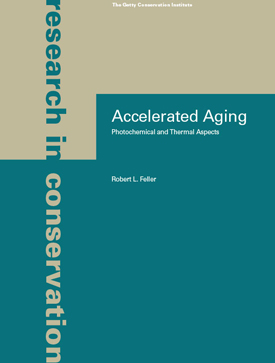
Accelerated Aging: Photochemical and Thermal Aspects
Robert L. Feller
1994
296 pages
PDF file size: 1.0 MB
Description
The book, representing the culmination of more than forty years of research, focuses on the long-term performance of materials such as wool, dyes, and organic compounds; their resistance to change when exposed to environmental factors such as oxygen, ozone, moisture, heat, and light; and their physical durability with handling and use over time. Processes of deterioration are discussed based on speeded-up laboratory studies designed to clarify the chemical reactions involved and their physical consequences.
Table of Contents
- Foreword
- Preface
- Acknowledgments
- Objectives of Accelerated Aging
- Introduction
-
Chapter 1 Classes of Stability
- Range of Stability
- Class of Stability
- Statistical Approach to the Probability of Failure
- Materials of Moderate or Intermediate Stability
- Summary
-
Chapter 2 Changes with Age That Are Measured
- Chemical versus Physical
- Mechanism
- Sensitivity of Measurement
- Choosing an Acceptable and Unacceptable Degree of Change
- Summary
-
Chapter 3 Kinetic Analysis of Change
- Equations Expressing Changes in the Concentration of Reactants
- “Order” of Reaction
- Sequential, Simultaneous, and Reversible Reactions
- How Properties Change in Time
- Summary
-
Chapter 4 Prediction of Useful Lifetime
- Empirical Equations
- Change According to Laws of Chemical Kinetics
- Sizmann and Frank Method
- Statistical Analysis of Probability of Failure
- Correlation
- Controls
- Summary
-
Chapter 5 Theoretical Aspects of Photochemical Deterioration
- To Activate Molecules, Radiant Energy Must Be Absorbed
- Photolysis
- The Primary Process
- Secondary Processes
- Reciprocity Principle
- Reactions Proportional to the Square Root of Intensity
- General Influence of Temperature in Photochemical Reactions
- Initiation
- Depth of Penetration of Light into Coatings
- Summary
-
Chapter 6 Influence of Wavelength
- Activation Spectra
- Effects Observed over an Extensive Range of Wavelengths
- Relatively Broad Regions of Sensitivity in the Ultraviolet
- Sharp Dependence on Wavelength
- Depolymerization of Poly(methylmethacrylate) and Other Acrylic Polymers
- Influence on Induction Time
- Apparently Nonspecific Response to Decreasing Wavelength
- The Idea of a Threshold of Photochemical Activity
- Action of 280-315 nm Wavelengths
- Wavelength Sensitivity in the Buildup and Dissociation of Peroxides
- Fundamental Difference Between Thermally Induced Auto-oxidation and Photo-oxidation
- Summary
-
Chapter 7 Practical Aspects of Testing
- Light Sources
- Selection of Limited Spectral Ranges
- Sharp Cut-off and Narrow-Band-Pass Filters
- Stress
- Experimental Strategies
- Special Considerations
- Simple Test for Ultraviolet Emissions
- Recently Prepared versus Aged Samples
- Summary
-
Chapter 8 The Effect of Moisture in Oxidative Degradation
- Normal Response
- Irregular Response
- Negligible Influence of RH
- Behavior at 0%,100%, and Intermediate Values of Relative Humidity
- Maximum Increase in Photochemical Deterioration, 0-100% RH
- Reactions Proportional to the Concentration of Water
- Relative Humidity in Accelerated Aging of Paper
- Regulation of RH During Experiments
- Permeability to Water Vapor
- Influence of Temperature and Humidity on Corrosion of Protected Metals
- Summary
-
Chapter 9 The Role of Oxygen
- Deterioration in the Presence or Absence of Oxygen
- Varying Ratio of Oxygen to Inert Gas
- Measurement of the Consumption of Oxygen
- Higher Than Normal Pressure of Oxygen
- Influence of Sample Thickness and Oxygen Diffusion
- Oxidative Induction Time Analysis
- Hydroperoxides
- Detection of Hydroperoxides
- Summary
-
Chapter 10 Thermally Induced Oxidative Deterioration
- The Arrhenius Equation
- Reactions Above and Below the Second-Order Transition
- Temperature, Tg
- Arrhenius-Based Shift Factor
- Indirect Way of Measuring Rates at High Temperatures: Thermogravimetric Methods
- Isothermal Differential Calorimetry
- The Equalized-Aging Process
- Problem in Choosing a Single Temperature at Which to Compare Different Systems
- Potential Contamination by Volatile Components
- Control of Humidity
- Classes of Thermal or Thermo-oxidative Stability
- Residual Thermal Stability
- Summary
- Chapter 11 Toward the Future
-
Appendix A: Photochemical Effects in the Discoloration of Wool
- Use of Monochromator in Australian Studies
- Effect of Heat and Different Light Sources
- Influence of Wavelength of Irradiance on Spectral Reflectance of Wool
- Conclusion
-
Appendix B: Dyes
- Concerning Mechanisms
- Physical State of Colorant
- Kinetics of Fading
- Influence of Temperature and Humidity
- Conclusion
-
Appendix C: Induction Time and the Auto-oxidation of Organic Compounds
- Kinetic Laws of Auto-oxidation
- Maximum Rate
- Induction Time
- Influence of Light
- Influence of the Concentration of Oxygen
- Influence of Inhibitors
- Conclusion
- Appendix D: Sensitivity to Wavelength as Determined by Sharp Cut-off Filters Calculations Used by Martin and Tilley (1971)
- Appendix E: Determination of Photo-initiation Rates by Measurement of Nitroxide Termination
- References
- Supplemental Bibliography
- Index
About the Authors
Robert L. Feller joined the Mellon Institute (now Carnegie Mellon Research Institute) in Pittsburgh as senior fellow of the National Gallery of Art Research Project on artists’ materials. In 1976 he became director of the Center for Materials of the Artist and Conservator through a grant from the Andrew Mellon Foundation. An Honorary Member of the American Institute for Conservation, he is director emeritus of the Research Center on the Materials of the Artist and Conservator at Carnegie Mellon Research Institute.